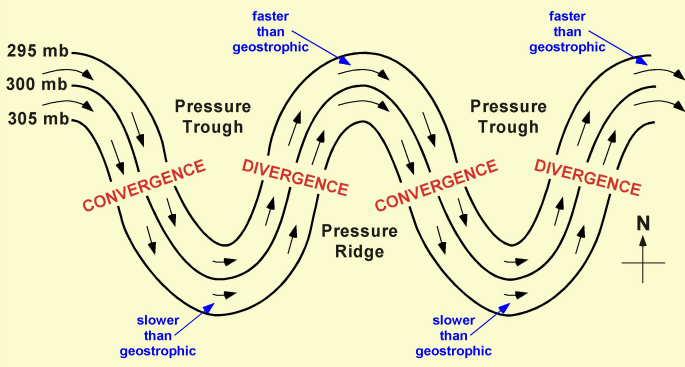High and Low Pressure Systems
The Development of High and Low Pressure Systems
Extratropical Cyclones:
Develop due to accelerations caused by imbalances between Pressure Gradient Force (PGF) and Coriolis force, primarily at jetstream levels.
Friction in the boundary layer destroys these cyclones over time.
Force Imbalances
Convergence and Divergence:
Convergence in an air column leads to increasing surface pressure due to weight gain in the column.
Divergence results in decreasing surface pressure as the column loses weight.
Vertical motions are linked to these fields; hydrostatic balance requires air to rise or fall in response to air column changes.
Cyclones (right) are associated with clouds and precipitation, whereas Anticyclones (left) correlate with clear skies.
Curved Flow
Flow Dynamics:
As air parcels transition from A to B, the PGF remains directed toward the center. Coriolis remains constant.
New southward PGF component reduces geostrophic balance, resulting in curved flow between isobars.
True flow becomes subgeostrophic (slower than geostrophic).
Conversely, in high pressure, PGF can cause a southward component leading to supergeostrophic speeds (faster than geostrophic).

Surface Pressure Changes
Strengthening and Weakening:
As surface pressure declines, low pressure centers get stronger, while high pressure centers weaken; the reverse holds true when surface pressure rises.
Curvature effects play a significant role in forming these systems.
Jetstreaks
Flow and Pressure Relationships:
Strong divergence is typically found on the NE side of a trough with surface cyclones forming below this area.
Conversely, strongest convergence occurs on the NW side.
The Friction Layer
Impact of Friction:
Friction consistently decreases wind speed, affecting the Coriolis force which becomes less influential compared to PGF.
It drives airflow towards low pressures and outward from high pressures, overall weakening these systems.
Stronger friction leads to greater turning of airflow, varying between 20-40º on land and 10-20º over water.
Effects of Heating and Cooling
Temperature Impacts:
Heating a uniformly cold air layer leads to rising pressure surfaces as temperature increases (latent heating).
Cooling the layer decreases temperature and pressure surfaces fall (radiative cooling).
Heating creates outward-directed PGF aloft which draws areas of low pressure at the surface and vice versa for cooling.
Development of High- and Low-Pressure Systems
A low pressure system intensifies when divergence aloft surpasses surface convergence, while it weakens if surface convergence exceeds divergence.
The role of cooling and associated convergence is critical for high-pressure systems, often more influential than curvature or jetstreaks.